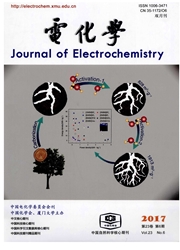

 中文摘要:
中文摘要:
这份报纸报导在胆碱氯化物脲(ChCl 脲) 的金 nanocrystals (Au NC ) 的过电位依赖者形状进化基于深最容易溶解的溶剂(DES ) 。生长过电位在调节 Au NC 的形状起一个关键作用,这被发现。Au NC 的形状进化连续地从凹面菱形的 dodecahedra (RD ) 到凹面立方体,八足类动物, cuboctahedral 盒子,并且最后,到空 octahedra (哦) 被小心地从 -0.50 在范围控制生长过电位到 -0.95 V 完成(对磅伪参考电极) 。另外,脲的存在在 Au NC 的形状进化是重要的。同样准备的 Au NC 的表面结构被扫描电子显微镜学(SEM ) 包括地描绘,传播电子显微镜学(TEM ) 和电气化学的研究。为 D 葡萄糖 electrooxidation 的同样准备的 Au NC 的 electrocatalytic 活动易感知地依赖于他们的形态学,这被表明。说明的结果使脱氢的葡萄糖在凹面 RD 和凹面上吸附了立方的 Au NC,这优先地在低电极潜力被转变到 gluconolactone。随后的 gluconolactone 氧化在八足类动物上有利地发生了与 { 111 } 截断的手臂并且空在高电极潜力的 OH。这研究开创一条新途径由把 DES 与电气化学的技术相结合开发 Au NC 的 surface-structurecontrolled 生长。另外,它为调节 NC 的 electrocatalytic 性质是重要的。
 英文摘要:
英文摘要:
This paper reports an overpotential-dependent shape evolution of gold nano-crystals (Au NCs) in a choline chloride-urea (ChCl-urea) based deep eutectic solvent (DES). It was found that the growth overpotentials play a key role in tuning the shape of Au NCs. The shape evolution of Au NCs successively from concave rhombic dodecahedra (RD) to concave cubes, octopods, cuboctahedral boxes, and finally, to hollow octahedra (OH) was achieved by carefully controlling the growth overpotentials in the range from -0.50 to -0.95 V (vs. Pt quasi-reference electrode). In addition, the presence of urea was important in the shape evolution of Au NCs. The surface structure of the as-prepared Au NCs was comprehensively characterized by scanning electron microscopy (SEM), transmission electron microscopy (TEM) and electrochemical studies. It was demonstrated that the electrocatalytic activity of the as-prepared Au NCs for D-glucose electrooxidation was sensitively dependent on their morphologies. The results illustrated that the dehydrogenated glucose adsorbed on concave RD and concave cubic Au NCs was preferentially transformed to gluconolactone at low electrode potentials. Subsequent gluconolactone oxidation occurred favorably on octopods with {111}-truncated arms and hollow OH at high electrode potential. This study opens up a new approach to develop the surface-structure-controlled growth of Au NCs by combining DES with electrochemical techniques. In addition, it is significant for the tuning of the electrocatalytic properties of NCs.
 同期刊论文项目
同期刊论文项目
 同项目期刊论文
同项目期刊论文
 期刊信息
期刊信息
